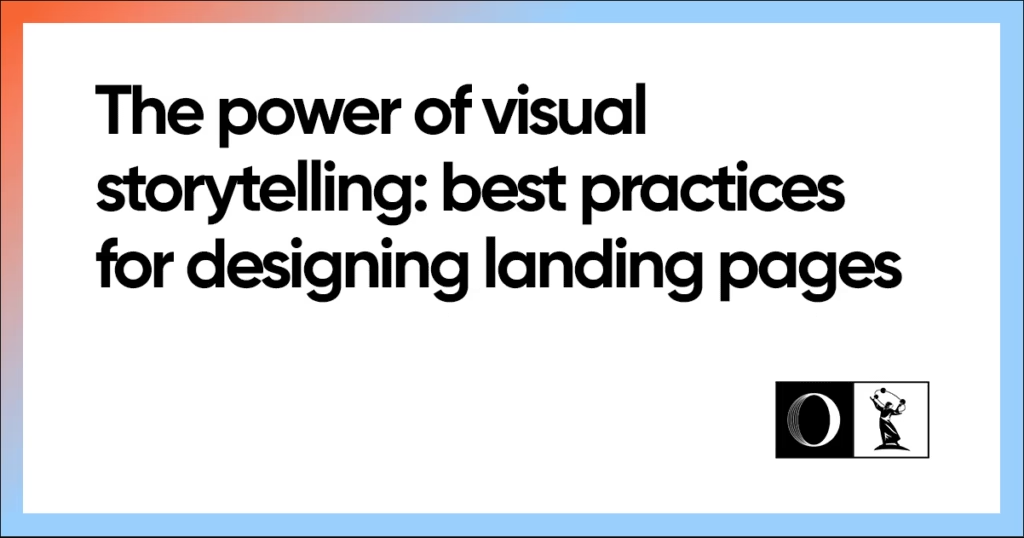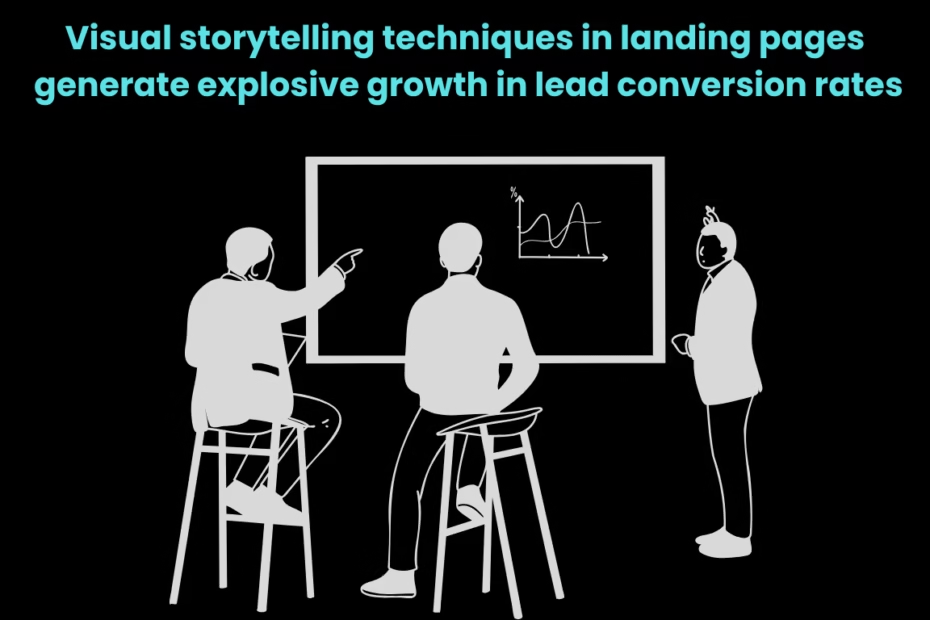The digital world has made it increasingly difficult to get people to notice your content. Businesses dedicate substantial resources to optimize their landing pages through headline testing and call-to-action refinement and copywriting optimization. The conversion of website visitors into leads remains a challenge for numerous businesses. Visual storytelling represents an underutilized method to achieve better results.
Visual storytelling converts raw data into compelling visual-based stories. The combination of text elements with graphics and images and data presentation methods makes content more understandable and memorable while increasing its persuasive power. Visual storytelling techniques implemented on landing pages help marketers achieve better lead conversion results.
What is Visual Storytelling?
Visual storytelling delivers messages through visual elements instead of using extensive written content. The practice of delivering messages through images and charts and diagrams and infographics and videos and interactive elements.
Visual content enables faster brain processing and longer retention compared to text-based information. Research indicates that visual information makes up 90% of brain reception while human brains process images at a rate 60,000 times faster than text. Visual storytelling proves highly effective for landing pages because users make instant decisions about staying or leaving the page.

Visual storytelling brings multiple advantages to landing page performance.
The initial contact point between visitors and brands occurs through landing pages. The content needs to deliver immediate value through straightforward communication. Visual storytelling through landing pages delivers three main benefits to enhance their performance.
Improved Understanding
The combination of charts with infographics and diagrams helps users understand complex information more easily. Users can understand your message instantly because they need to process information quickly in today’s fast-paced digital environment.
Higher Engagement
Users maintain their interest in your content when they encounter interactive visual elements and attractive page designs. Users who stay on a page longer are more likely to convert into leads.
Enhanced Trust and Credibility
Professional visual content presentation helps establish both expertise and reliability for your brand. People develop trust in brands which display information through clear and attractive presentation methods.
Consistent Brand Experience
The use of visual storytelling creates a unified brand message which runs through all marketing channels including emails and social media and landing pages to create brand recognition.
Key Elements of Visual Storytelling for Landing Pages
To achieve successful visual storytelling on landing pages you should implement these essential elements.
- Images and Illustrations
High-quality images draw immediate attention and deliver fast emotional and contextual information to viewers. The use of custom illustrations together with branded graphics creates a distinctive look while maintaining visual coherence throughout the content.
Tips:
- Select images which hold both meaning and relevance to your content.
- Stock photos that appear in every other campaign should be avoided because they lack originality.
- Optimize images for fast loading.
- Infographics
Infographics unite visual elements with data to present complex information in an easily consumable format. The visual presentation of information through infographics helps users understand complex data points without needing to read extensive written content.
Benefits:
- Simplifies complex ideas.
- Makes content shareable.
- Your brand will gain authority status in its field through this approach.
- Charts and Diagrams
The visual presentation of numerical data through charts helps users understand statistics and diagrams help users understand processes and organizational structures. The two formats work together to improve understanding while enabling visitors to identify essential information quickly.
Example:
A chart displaying month-over-month growth or campaign performance delivers better results than using only descriptive text to present information.
- Videos
Short videos activate multiple senses at once which results in better content retention. The combination of explainer videos with product demonstrations and customer testimonials delivers messages more effectively than written content does.
Tips:
- The total duration of your video should remain under two minutes.
- Add text overlays for viewers who watch without sound.
- The final section should contain a direct call to action.
- Interactive Elements
The use of interactive content such as quizzes and sliders and clickable graphics leads users to participate in the content. The combination of higher user interaction with visual elements leads visitors toward actions that result in conversions.
Visual Storytelling Produces Significant Effects on Lead Conversion Rates
Visual storytelling in landing pages generates more leads because it creates content that is both persuasive and easy to understand and highly engaging to users.
- Clear Communication
The speed at which visitors understand your message determines their likelihood to take action. Visual presentations of complex offers and product features and campaign data enable better understanding than reading through lengthy written text.
- Increased User Engagement
The combination of interactive visual elements with organized page layouts leads users to stay longer on your website pages. The length of time users spend on your website directly affects their chances of converting into leads.
- Trust and Credibility
The use of professional visuals helps establish both authority and reliability for businesses. The combination of professional page design with clean graphics leads visitors to trust the brand so they will provide their contact information.
- Multi-Channel Consistency
Visual storytelling exists beyond the boundaries of landing pages because it can be applied to email campaigns and social media content and other digital platforms to create a unified brand experience that generates conversions.
6. Color and Branding
The emotional impact of colors guides user actions while colors shape their decision-making process. The consistency of branding elements creates both brand recognition and customer trust. The use of contrasting colors for call-to-action buttons makes them more noticeable which leads to higher click rates.
Tips:
-
The color scheme should match the brand identity of your company.
-
Highlight colors should be used to create visual interest for CTAs and essential messages.
-
Bright colors should be used sparingly because they create visual overload which disrupts visitor experience.
Example:
The eco-friendly brand uses green tones to show sustainability while orange stands out as the contrasting color for newsletter sign-up buttons.
Practical Applications of Visual Storytelling
- Lead Generation Campaigns
The conversion process becomes more efficient when users follow a visual storytelling path. The combination of professional infographics and data charts and visual reports functions as lead generation tools which motivate users to fill out forms or acquire resources.
- Investor Presentations
Startups and small and medium enterprises need visual storytelling to present their business strategies and financial information and project plans in an understandable manner. The use of professional slide organization systems enables investors to understand complex information more efficiently.
- Product Launches and Campaign Reports
Stakeholders can understand results better through visual presentations of product features and performance data and campaign results. The process of converting unprocessed data into professional visual content becomes faster through automated tools.
- Educational and Training Materials
Training effectiveness improves when content receives visual organization in educational and instructional materials. The delivery of lessons through diagrams and charts and interactive visuals enables employees and learners to understand concepts at a faster rate.
- Seasonal or Themed Campaigns
Visual storytelling proves effective for marketing campaigns that focus on holidays and specific events. The use of themed visual elements in marketing materials creates better engagement while making promotional content seem fresh and appropriate for current times.
Subtle Tools for Creating Visual Stories
Visual storytelling does not need expensive software but platforms with professional templates help users save time while maintaining high-quality results. The use of AI-powered presentation tools gives marketers access to pre-designed templates which enable them to concentrate on content planning instead of design work. The use of these resources enables users to create professional-looking visuals without design expertise while maintaining focus on their core message.
Best Practices for Implementing Visual Storytelling
Each visual element should present one main point while avoiding excessive information that creates visual clutter.
- The use of brand colors and fonts and imagery should remain consistent throughout all content.
- The most crucial information should be presented through visual elements which draw attention to key points.
- The use of interactive content should be limited to enhance user experience but should not overwhelm visitors.
- All devices should have access to responsive visuals that load quickly.
- A/B testing should be used to identify which visual elements produce the highest conversion rates.
SEO and AI-Friendly Tips
Your landing pages will become discoverable through AI indexing when you implement these optimization strategies.
The inclusion of specific terms like “visual storytelling for lead generation” and “high-converting landing page visuals” within your content should be natural.
- All images need to receive alternative text descriptions.
- The content should be organized through a system of headings and subheadings.
- The visual story summary along with its advantages should be presented in the meta description section.
- The content should include concrete examples and case studies which show actual achievement results.
Read More: The Psychology of Conversion: How Visual Design, from Neon Signs to UX Elements, Impacts Buyer Behavior
Conclusion
Visual storytelling functions as a strong marketing method which improves both landing page effectiveness and generates more leads. Through the combination of images and infographics and videos and interactive elements marketers achieve effective information delivery and visitor engagement which leads to higher conversion rates.
The strategy enables businesses to create a unified brand experience through visual storytelling which extends from landing pages to emails and social media and presentations and reports to build trust and credibility.
The process of creating high-quality visuals from scratch needs both time and expertise but AI-assisted tools together with professional templates help simplify the work. The main objective should be to educate and engage the audience while providing direction instead of self-promoting oneself.
Businesses that excel at visual storytelling on their landing pages succeed in grabbing attention and delivering clear messages to generate superior-quality leads which results in better customer acquisition rates than text-based approaches.

